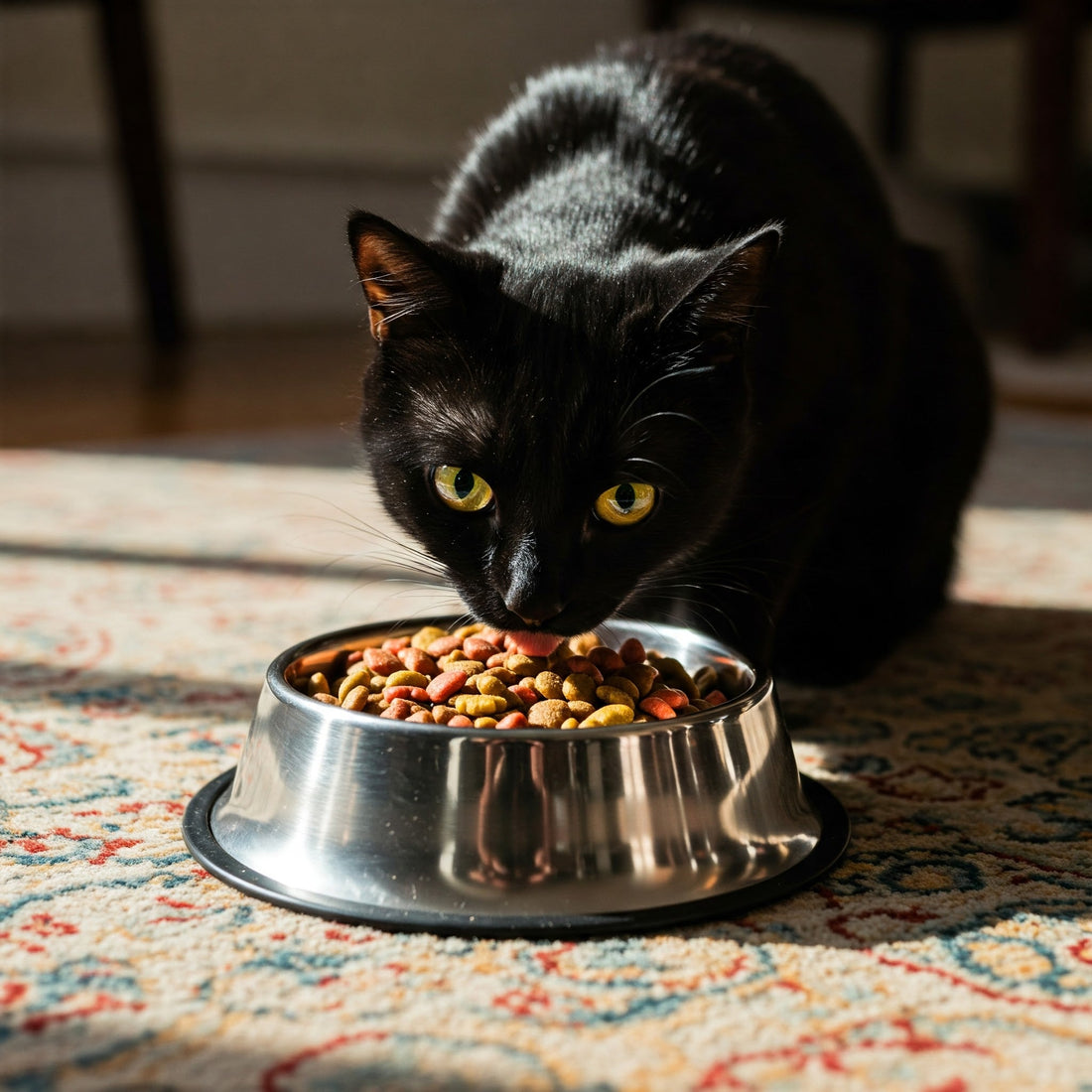
How to Feed Your Cat Well Without Breaking the Bank: Nutritious & Affordable Solutions
Share
The rising cost of pet food has left many loving cat owners standing in store aisles, turning packages over in their hands while doing mental math that never quite adds up. That gnawing tension between what our cats deserve and what our budgets allow creates a special kind of heartache - one familiar to anyone who's ever compared the price of premium kibble to their grocery total. But here's the quiet truth they don't print on fancy pet food labels: nourishing your feline friend doesn't require mortgaging your sanity. With some strategic thinking and a dash of feline nutrition knowledge, you can craft a diet that keeps both your cat's body and your bank account healthy.
Cat Bowl and Water Feeder Dispenser
Understanding your cat's non-negotiable needs is the foundation of budget-friendly feeding. As obligate carnivores, cats require animal protein to survive - their bodies literally can't process plant-based nutrients the way humans or dogs can. This biological reality explains why cheap foods packed with corn and fillers leave cats malnourished despite full bellies. The protein source matters tremendously; while whole chicken or salmon sound ideal, veterinary nutritionists confirm that properly processed by-products (organs, bones, and tissues humans don't eat) often deliver equal nutrition at lower cost. The key lies in reading past marketing buzzwords to identify foods meeting AAFCO standards with affordable protein concentrates rather than expensive whole-meat showpieces.
Dry versus wet food presents the first real budget crossroads. Kibble certainly wins on price per ounce, but its lack of moisture and higher carbohydrate content can lead to long-term health issues like diabetes and kidney disease - creating vet bills that dwarf any grocery savings. The solution lies in strategic blending: using a high-quality dry food as the base (look for 40%+ protein from animal sources) and stretching it with affordable wet food or homemade moisture boosters. A single can of pâté-style food divided over several meals, mixed with warm water to create a gravy, can make dry kibble more appealing and hydrating while keeping costs manageable. For the truly budget-conscious, plain cooked chicken thighs (far cheaper than breasts) simmered into a broth provides both protein and hydration when poured over kibble.

The bulk section of pet stores often feels like the budget shopper's promised land, but those giant bags come with hidden risks. Unless you have multiple cats or a very large feline, the savings may disappear when food goes stale before finishing the bag. Oxidation degrades nutrients and fats over time, turning what seemed like a bargain into second-rate nutrition. Instead, consider teaming up with fellow cat owners to split bulk purchases, or invest in airtight containers with oxygen absorbers if buying larger quantities. Store brands at major pet retailers frequently offer surprising quality - many are manufactured in the same facilities as premium brands but without the fancy packaging markup. The secret is checking the guaranteed analysis rather than assuming price correlates perfectly with quality.
Homemade food dances temptingly in many budget-conscious minds, but this path requires careful navigation. While substituting expensive commercial foods with cooked meats seems logical, cats require precise balances of taurine, arachidonic acid, and other nutrients nearly impossible to replicate without supplements. The false economy of homemade diets becomes painfully clear when deficiencies lead to emergency vet visits. That said, strategic supplementation of commercial foods can stretch meals safely. Adding lightly cooked eggs (a complete protein source), small amounts of liver (packed with nutrients), or even plain yogurt (for probiotics) can enhance nutrition without requiring full DIY meals. Always consult your vet before making significant dietary changes - an upfront office visit costs far less than treating nutritional imbalances later.
Timing your purchases creates unexpected savings. Pet food manufacturers typically release new formulas in January, making December prime time for clearing out previous versions at discounts up to 50%. End-of-month sales help stores meet quotas, while holiday weekends often trigger unadvertised specials. Signing up directly for manufacturer newsletters frequently unlocks better coupons than third-party sites, and many brands offer rebates for submitting receipts online. Local buy-nothing groups sometimes have unopened foods that didn't agree with other cats - always check expiration dates and storage conditions.
Interactive Swinging Cat Toys Feeders
The treats aisle is where even disciplined budgeters often falter. Those tiny bags with cute shapes carry outrageous markups, yet cats don't care about dinosaur-shaped kibble. Instead, use their regular kibble as treats (reserve a portion from each bag), or invest in a bag of freeze-dried liver that lasts months when broken into pea-sized pieces. For cats who crave variety, rotating different protein sources of the same brand prevents flavor boredom without expensive extras. The money saved on frivolous treats can upgrade your cat's main meals significantly.
Special needs like prescription diets present the ultimate budget test. Before resigning yourself to astronomical prices, ask your vet about therapeutic over-the-counter alternatives - many urinary or hairball formulas now exist without mandatory vet markups. If prescriptions are unavoidable, comparison shop between online pharmacies (with vet approval) and ask about manufacturer assistance programs. Some clinics offer loyalty discounts for long-term medications, and compounding pharmacies can sometimes create cheaper generic versions.

The most profound savings come from preventive care. That slightly pricier food with better protein quality may prevent obesity-related diabetes down the road. The extra dollar spent on a moisture-rich option could stave off kidney disease. Viewing food costs through this long-term lens transforms decisions from penny-pinching to investment strategies. Your cat's glowing health - visible in their shiny coat, bright eyes, and energetic play - becomes the ultimate proof that smart budgeting and proper nutrition can walk hand in hand.
The psychological aspect of feeding our cats often goes unexamined in budget discussions. Many owners experience guilt when choosing more affordable options, as if they're somehow failing their feline companions. This emotional burden frequently leads to cycles of overspending followed by financial stress - neither of which actually benefits the cat. The truth is far more comforting: cats measure love through consistency and attention, not price tags. That evening ritual of pouring food into their favorite bowl matters infinitely more than whether it came from a boutique pet store or a supermarket shelf. By releasing ourselves from the marketing-fueled myth that only the most expensive foods demonstrate real care, we free up energy to focus on what truly nourishes our cats - balanced nutrition served with generous helpings of playtime and affection.
Seasonal adjustments to your cat's diet can unlock both nutritional and financial benefits. Summer months often see cats drinking more water, making it an ideal time to slightly increase the proportion of dry food in their diet (provided fresh water remains abundantly available). Winter's colder temperatures may call for boosting calorie content with affordable protein toppers like canned sardines in water (much cheaper than specialty cat foods). Seasonal produce can also play a supporting role - pumpkin puree (not pie filling) purchased during autumn harvest sales makes an excellent, budget-friendly source of fiber that helps with hairballs and digestion. These small, natural adjustments work with your cat's biological rhythms while keeping costs variable throughout the year.
The social dynamics of multi-cat households present unique budget challenges that single-cat owners rarely consider. Free-feeding becomes impractical when one cat needs weight management kibble while another requires calorie-dense food, leading to expensive separate feeding setups. Creative solutions like microchip-activated feeders (a significant upfront investment that pays off long-term) or scheduled meal times with cats in separate rooms can prevent food waste and ensure each cat gets appropriate nutrition without doubling your food budget. For households with senior cats struggling to maintain weight, adding a shared communal bowl of high-calorie supplementary food allows for natural grazing without the expense of full separate diets. Observing your cats' natural eating behaviors often reveals unexpected opportunities for savings - the cat who prefers many small meals may do better with measured portions of dry food left out, while the one who gorges benefits from puzzle feeders that slow consumption.


